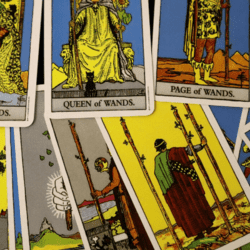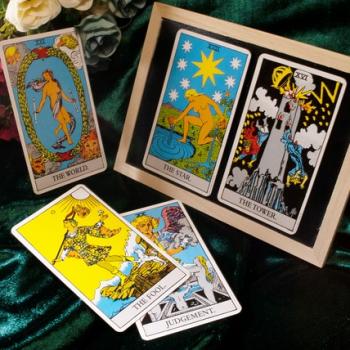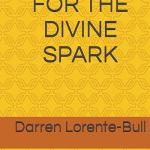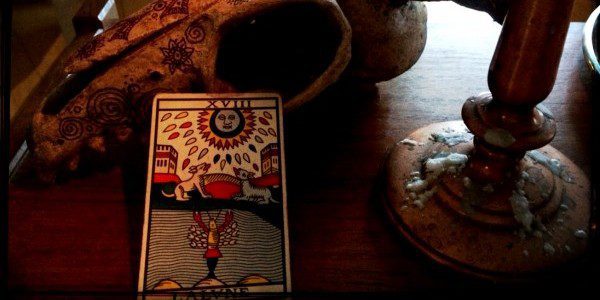
How do you survive your nightmares? The nightmare of Trump, for some, or a recurrent nightmare, disclosing your deepest fears and concerns?
In my work I also do dream readings. I’ve started the year with quite a few of them. This made me think that perhaps we tend to dream more intensely when we are at the crossroads, or crossing thresholds in our lives.
As most readers of this column know now, I use the Tarot to question everything. I put this on my Zen inclination that calls for investigating into what arises, yet, unlike in Zen meditation where I tend towards no question, or identification with the object, with the cards I go to a different beyond.
This is the storyworld. I like stories. And stories arise out of questions. The best stories arise out of curiosity and a willingness to know what happens in our encounters with others, people, nature, animals, spirits, and the like. So I am curious about my dreams when these encounters take the form of the fantastic.
Here is an example of how I spin narratives off my dream world and what I get out of. For a few totally whacked dreams, one lucid, you’re welcome to check my dream tag on my website. You will be entertained. I promise.
Let me show you what I do when I have a dream whose message – if I need one – I wove into the images of the tarot.
The dream world
What I do first is recount the dream in as many details as I can. Then I break the dream down into its major components. I create a sequence of important scenes. For each scene I then pull a card from the Tarot’s major arcana. I create sets of two cards that I then read en bloc.
If I need advice, I then shuffle the cards again, and use the efficient 5-card layout ‘Do and Don’t.’
The mistress and her ring
3 nights ago I had a very clear dream. The night before I watched the film about Jung and Freud, A Dangerous Method, all about a failed love affair and friendship. If you’ve seen this film, you will recognize how it colors my dream below, but my dream is still of my mind’s concoction, and hence it has value all its own.
I number each significant sequences in the dream according to temporal chronology. Here it goes:
(1) I am at a conference, roaming about in the coffee break in the main hall.
(2) I see a tall man seated in a chair. In my dream I recognize him as a friend. I hurry to go over to him.
(3) While still seated, the man gives me a prolonged hug. This occurs to me is odd. When he releases his grip, he gives me another tight hug, which begins to make me feel uncomfortable.
(4) The reason for the experienced unease has to do with feeling my partner, who is also at the conference, watching with exasperation, as if anticipating work on this man: ‘Is she going to read cards again?’ – there is no conference I ever go to in real life without reading cards for all the scientists I know, or who show an interest.
(5) I ask the man, ‘are you all right’, and he says, ‘no,’ shaking his head vigorously. He tells me what’s wrong, that he made a big ring for his mistress, Esther, and now he regrets having promised it to her. He doesn’t want to give her the ring, but the mistress insists that she must have it.
Now he is torn. He tells me the price: 2.2 million. I say, ‘that’s a lot of money for a diamond ring,’ assuming it’s a diamond ring, and then he retorts: ‘Well, I’m a lot richer than you and your partner.’ I find this statement odd, and wonder where it comes from.
(6) Instead of pursuing the malice, I ask the man instead: ‘How does your wife feel about all this?’ He remains silent.
(7) My sister then appears out of the blue, and she shows me the ring. Surprise, surprise. It’s not a diamond ring. It has a granite stone, very large, and cut in rectangular form. One of the 4 ‘clasps’ holding the stone is broken, and my sister is trying to fix it. I have faith in her, as she has a knack for fixing everything in real life too. But she fails.
(8) I look behind me at man again, and wonder to myself. What is there to do about someone’s regret or ambivalence? I feel like telling the man that if he doesn’t want to give his mistress the ring, then he shouldn’t, and that’s that.
(9) Instead, I suggest that I read his cards. I take out my pack, and fiddle with them while I’m also drinking coffee, and I manage to spill the coffee on the cards causing me to feel irritation. As I try to wipe off the liquid, being thankful that only the margins got stained, I notice the bottom card: It’s the Hanged Man.
I wake up.
Dream reality
As you can see, this dream is not only coherent, but also filled with emotions, ranging from despair to anxiety and the desire to do something. The general feeling is, however, one of helplessness.
Let’s put down some cards, to see what we can make of this, apart from offering a standard dream interpretation, which can be summed up along these lines, if Freud were to have a say in it: Someone married the wrong person, putting a ring on her finger that should have belonged to another lover.
Because the dream woman is impossible, the ring in the dream is one that spells out ‘solid house’, not ‘brilliant cutter’. Guilt ensues, and the dream picks up on this reversal: The mistress cannot have the expensive ring, other than by proxy, because, by law, it belongs to the wife, who, however, gets the lesser thing. And that’s regretful. A classic. In this dream it comes out entangled.
I find that ‘laws’ are very interesting in dreams, and the way in which we give ourselves permission or not to pursue something comes to the conscious surface in very interesting ways.
But let’s get back to the cards, and see what they have to say, and get a sense of how we disentangle what is at stake here.
I’ll give a short interpretation of each card, as it connects to each of the 9 scenes. I repeat the gist of each scene for the sake of maintaining attention and coherence.
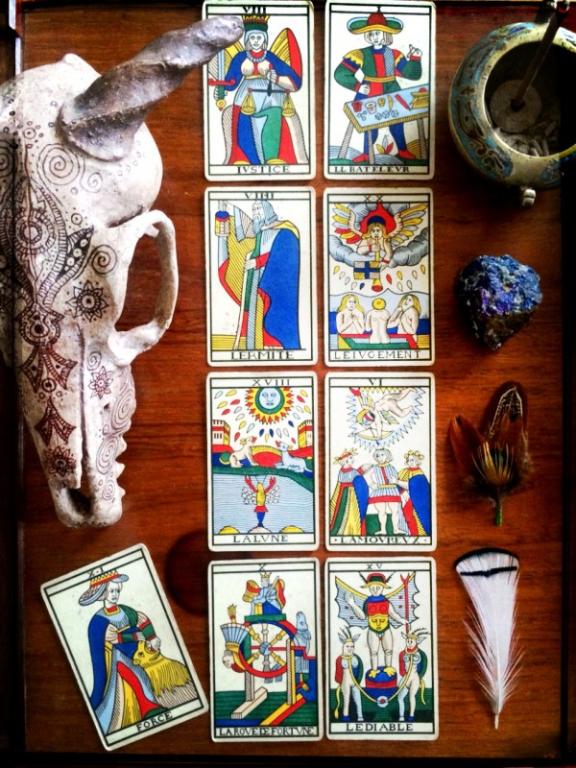
I’m at a conference. Justice.
This is self-evident. Ideally, we go to conferences to learn. The fact that we are with Justice here allows us to extend our interpretation to the idea that truth should have priority over knowledge, which is not always the case at conferences. What I take from this card, then, is that in dreams the possibility to learn truth and not just acquire knowledge is higher than in conscious states. Right. I could think about this one alone for some time to come…
I see a seated man. Magician.
In the pack I use here, the Jean Noblet Marseille tarot, the Magician is standing. In the first Tarots that we know of, for example the Visconti-Sforza pack, the Magician is seated. But still, a Magician is a magician, a con artist; young and virile, and full of ideas, turning the impossible into the possible. But do we trust him? He seduces us with his skills, and we go with the enchantment. Perhaps the alternative realities that the Magician creates are good enough. Yet he looks as Justice, with an understandable apprehension: You don’t fuck with Justice.
Prolonged hugs. The Hermit.
A hermit takes his time. Even in an embrace, he’s probably thinking of something else, unless he is the Zen kind, in which case, he’ll give you a hug full of presence. Yet a certain weariness is felt. The Hermit lacks the Magician’s vitality. What does his cloak hide? One tends to be fascinated with a monk’s body under his robes and wraps.
My partner is impatient. Judgment.
We are certainly in a public space. Every move and gesture is potentially watched, and hence interpreted and misinterpreted. Gossip can travel around faster than the angel can blow his trumpet. What are we all afraid of? What will be disclosed? And why does this academic always have to read the cards for the sceptics? It’s not sure that enlightenment is on their agenda. Let alone truth.
Esther’s granite ring. The Moon.
Who is Esther? Someone who fascinates, like the Moon does. Or the wife herself. You never know with the Moon. Why can’t she have the ring? The presumption is that an expensive ring like that can only be a diamond ring. Its durability is something you cannot argue with.
But what is the man really afraid of? That Esther will put a spell on him, appearing in his nightmares if he fails to give her that ring? Is Esther really the wife the man didn’t want to get, but ended up with? ‘Here’s a granite stone for you. I gave the diamond ring to another, the one I lost my heart to.’ Freud would say yes.
The Moon discloses the deepest fears. And desires. What you see is precisely not what you get. The man made the ring for his mistress, and now he has second thoughts. Why? The Moon maintains her mysteries. You can ask all the questions in the world. The Moon will not disclose any answers you can use. It will only stir your madness. Mixing things up, messing with reversals and reflective mirroring.
The wife. The Lovers.
The wife knows. She knows about her husband. Well, as they say, a woman always knows. When a man is caught between two women, what is there to do? You can’t fix his ambivalence. The wife knows that her man has his eyes on another. Her hand on his heart, flashing her own diamond, perhaps (or was it granite?) makes a claim: ‘You’re mine.’
But that statement is a gestural statement that only discloses her desire for union. But how does this union manifest on the reciprocal level? As a broken heart? Anxiety? ‘What it I’m not the one?’ As claims in the name of law? ‘I took you as my husband in the eyes of witnesses.’ But is that enough if you’re emotionally invested and expect the same, and if you identify with these emotions? Most people do. It’s hard to maintain a Zen mind about everything. Nasty business, the Lovers business.
My sister appears. The Wheel of Fortune.
So, the ring is not a diamond ring, but granite. It needs fixing too. Whoa. What does this mean? What does granite have that a diamond doesn’t? For once, it lacks the shining brilliance, especially if it’s cut. Granite lacks internal structures. It’s hard and rough. It’s massive. You can build pyramids with it, tall columns and monoliths. Your house is made of granite.
Granite is impressive, where a diamond is merely a cliché for the durability of marriage contracts. What a joke, no? I know many women who keep the precious rock after discarding the husbands. What is all that about? Why not see beyond the cliché? But how many do it?
Granite is solid and stolid, yet forgetting that it goes around in a ring or a wheel that spells out change. You can read these changes on the surface of granite. A diamond ring stays the same, but isn’t this also an illusion? Not even diamonds can escape the Wheel of Time.
And yet. A diamond ring bedazzles. It’s your house of cards, yet made of steel and glass. It can cut itself. It’s the ultimate weapon. But why can’t we see it in the dream?
The diamond ring only exists in perception. What we see in the dream is only the granite. What happened to the diamond ring? It’s certainly there, on a plane that is not articulated concretely. The ring intended for Esther is made of granite. But she is not the wife in the dream, the one with the house that the granite contributes to. Does the wife have the diamond in real life, if there is a wife for this man? If yes, what’s it to her, beyond flashing it to the public?
How can you fix the ambivalence? The Devil
You can’t. Ambivalence is a nasty demon. This one or that one? Which one to choose? The Devil is a higher order Lovers card. Higher in the sense that’s it’s nastier. You can’t get out of your attachment to your ambivalence. That would require a clear mind and vision. The Devil’s job is to convince you that you have no alternative. You are caught. Or the other is caught. Or you are both caught in you attachment: yours to your desire to help, his to his complacency.
I take out the cards to read them. Force.
In the dream, after the coffee stains, the Hanged Man appears. Here we get the card of force. What is this woman trying to overcome? What is the beast she’s struggling with?
Against the background of the image of the Hanged Man, which for me spells out regret, there’s not much you can do. The Hanged Man has no agency, hence the regret. The only thing you can do is to accept your resistance to regretting the situation, and get on with the program.
You feel like telling yourself to put it down. Put your monolith down. Yours and the other’s. What’s the purpose of holding on to rings, diamond or granite? Not even reading the cards can help you. You can struggle with what is hanged in you, but what is the purpose of that struggle?
How can you help someone who has regrets? In my ‘Cards and Zen’ work with people, called Nonreading, I just tell them to put it all down. The cards are good at spelling out a method, and a way of going about it, so that ‘putting it all down’ does not appear as a grand abstract, or a grand cliché. It works wonders.
Course of action
As you can see, one can go on with a dream reading. A dream is both a complex world, but also very simple and straightforward.
If a course of action is desired after having an interesting dream, what you can do is proceed to laying down more cards, taking your point of departure in the question that begs itself, here, ‘How can this situation be helped?’, maintaing some distance.
Or if you want to be more involved, then, how can you help someone who has regrets? Including your own?
The general function of the cards on the table is precisely to raise your awareness about what’s happening, how you feel about it, and why it’s a good idea to think of ways of detaching.
For this I do a 5-card reading.
Let me give a quick example in conclusion.
The cards on the horizontal axis tell us something about the situation outside of the dream world. The card on top gives advice for a concrete plan of action. The card at bottom tells us what to avoid.
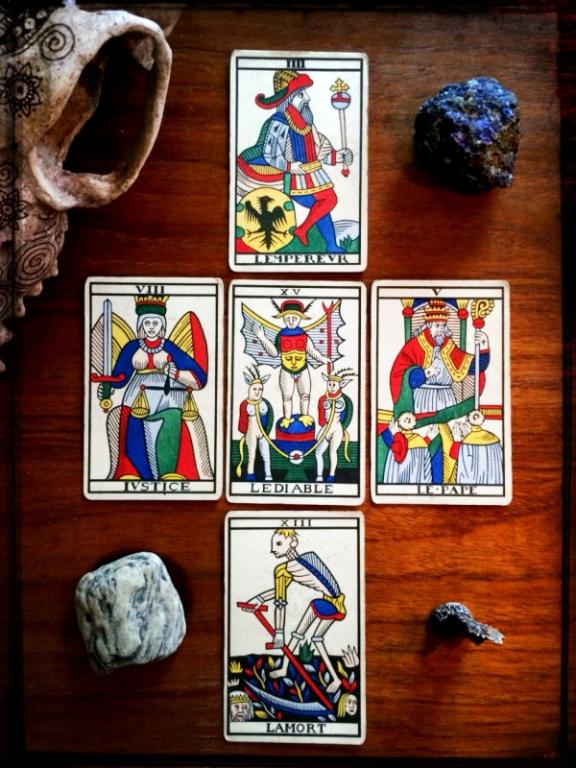
Justice, The Devil, The Pope
A process of seeing and confronting the demons has started. Mainly through spiritual guidance. What the Popes of the world are known for, when they are also competent, is giving you pointed out instruction. Not in the sense of telling you what to do. No one wants to be told what to do.
The smart spiritual counselors will know better than to tell you what to do. They will point you in the right direction so that you can make your own realizations. But digging into your unconscious is still something you have to do to begin with. Are you able to distance yourself first from whatever confronts you, and apply some discernment in the face of the illusion of ‘no alternative’? A tough one.
Recognizing the demons of attachment is a process that you do with your self, with no one else involved. You are alone. You are always alone. Get that through your head. No one else can see your truth. Only you can. That’s why the Pope here is not turned towards your inner demons. He is turned towards the possibilities that come after making some realizations. He points to the future, however uncertain that always is.
Hence the advice here is to take action in your own hands. Imperially.
The card in the position of DO is the Emperor. Make a plan and follow it through. Make that appointment with the higher lama, or teacher. Sit and listen. Imperially.
When the Emperor is smart, he realizes that his power and sovereignty is in acknowledging the ones he rules over. Listen to them.
What is a good idea to avoid is making drastic decisions of the kind that makes ultimate pronouncements: ‘Off with his head’ is not a good idea here, as it will accomplish nothing but spilled blood. Not all sacrifices require blood.
The card in the position of DON’T is Death. Don’t do Death. Don’t kill it.
Given the Pope in the picture, the only thing we can take from here is the fact that there’s a teaching in it. The situation can be helped by seeing it as a real and truthful opportunity for learning how to confront attachment and ambivalence; how to gain vision and wisdom in the middle of bondage.
You can exorcise your demons by taking your meditation to a higher level. You learn a lesson, you teach it to others.
In the context of my dream, as it was flavored by watching a film featuring titans of psychoanalytical thinking and practice, whose work I’m familiar with, I’d say that what the cards call for here, is not deconstructing the past, the focus of psychoanalysis (Justice is a woman of method), but rather of confronting present illusions (Justice + The Devil).
I like it that the cards suggest what I started out with musing about, my Zen inclination: ‘Go Zen. Befriend your demons and learn to recognize their nature. Control your mind.’ Controlling your mind has little to do with the past. It has to do with the present.
The dream itself has reflective content, as there are moments in it that are explicitly cognitive, not just emotionally felt: ’How can I help?’, is in itself a selfless attitude, already disclosing the capacity to detach. so, detach. Put it down.
From a storytelling point of view, what can I say? Are you still reading? If you are, then it’s because you found this captivating. There is no greater gift than the gift of sharing captivating stories with others. Thank you.
Enjoy your dreams.
♠
More dream work and other cartomantic activities? Stay in the loop, or browse my webpage for concrete counselling sessions. A brand new course in advanced readings, Radiant Readings, will open for registration on February 3.

Patheos Pagan on Facebook.

the Agora on Facebook
The Cartomancer is published twice monthly on the Wednesdays here on the Agora. Subscribe via RSS or e-mail!
Please use the links to the right to keep on top of activities here on the Agora as well as across the entire Patheos Pagan channel.








